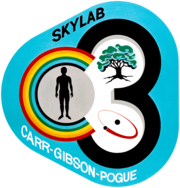
Back سكايلاب 4 Arabic Скайлэб-4 Byelorussian Скайлаб 4 Bulgarian Skylab 4 Czech Skylab 4 Danish Skylab 4 German Skylab 4 Spanish Skylab 4 French Skylab 4 Galician סקיילאב 4 HE
 The final view of Skylab, from the departing mission 4 crew | |
| Operator | NASA |
|---|---|
| COSPAR ID | 1973-090A |
| SATCAT no. | 6936 |
| Mission duration | 84 days, 1 hour, 15 minutes, 30 seconds |
| Distance travelled | 55,500,000 km (34,500,000 mi) |
| Orbits completed | 1214 |
| Spacecraft properties | |
| Spacecraft | Apollo CSM-118 |
| Manufacturer | North American Rockwell |
| Launch mass | 20,847 kg (45,960 lb) |
| Crew | |
| Crew size | 3 |
| Members | |
| EVAs | 4 |
| Start of mission | |
| Launch date | November 16, 1973, 14:01:23 UTC |
| Rocket | Saturn IB SA-208 |
| Launch site | Kennedy LC-39B |
| End of mission | |
| Recovered by | USS New Orleans |
| Landing date | February 8, 1974, 15:16:53 UTC |
| Landing site | 31°18′N 119°48′W / 31.300°N 119.800°W |
| Orbital parameters | |
| Reference system | Geocentric |
| Regime | Low Earth |
| Perigee altitude | 422 km (262 mi) |
| Apogee altitude | 437 km (272 mi) |
| Inclination | 50.04 degrees |
| Period | 93.11 minutes |
| Epoch | January 21, 1974[1] |
| Docking with Skylab | |
| Docking port | Forward |
| Docking date | November 16, 1973, 21:55:00 UTC |
| Undocking date | February 8, 1974, 02:33:12 UTC |
| Time docked | 83 days, 4 hours, 38 minutes, 12 seconds |
 Due to a NASA management error, crewed Skylab mission patches were designed in conflict with the official mission numbering scheme.  Left to right: Carr, Gibson and Pogue Skylab program | |
Skylab 4 (also SL-4 and SLM-3[2]) was the third crewed Skylab mission and placed the third and final crew aboard the first American space station.
The mission began on November 16, 1973, with the launch of Gerald P. Carr, Edward Gibson, and William R. Pogue in an Apollo command and service module on a Saturn IB rocket from the Kennedy Space Center, Florida,[3] and lasted 84 days, one hour and 16 minutes. A total of 6,051 astronaut-utilization hours were tallied by the Skylab 4 astronauts performing scientific experiments in the areas of medical activities, solar observations, Earth resources, observation of the Comet Kohoutek and other experiments.
The crewed Skylab missions were officially designated Skylab 2, 3, and 4. Miscommunication about the numbering resulted in the mission emblems reading "Skylab I", "Skylab II", and "Skylab 3" respectively.[2][4]
- ^ McDowell, Jonathan. "SATCAT". Jonathan's Space Pages. Retrieved March 23, 2014.
- ^ a b "Skylab Numbering Fiasco". Living in Space. William Pogue Official WebSite. 2007. Archived from the original on February 2, 2009. Retrieved February 7, 2009.
- ^ "'Three happy rookies' off on longest space voyage". Eugene Register-Guard. (Oregon). Associated Press. November 16, 1973. p. 1A.
- ^ Pogue, William. "Naming Spacecraft: Confusion Reigns". collectSPACE. Retrieved April 24, 2011.